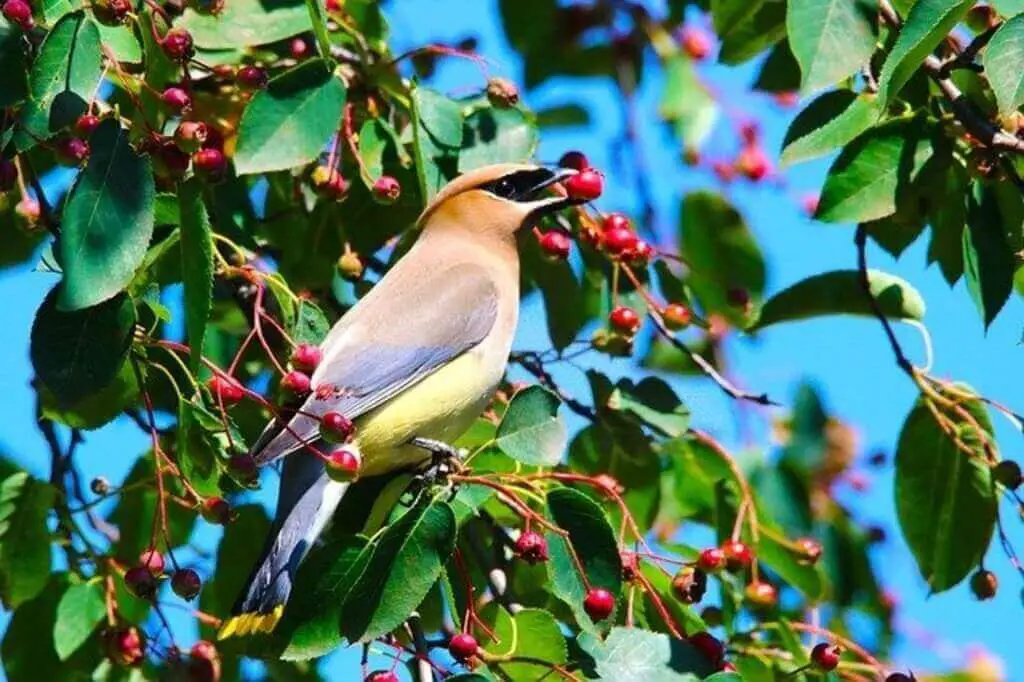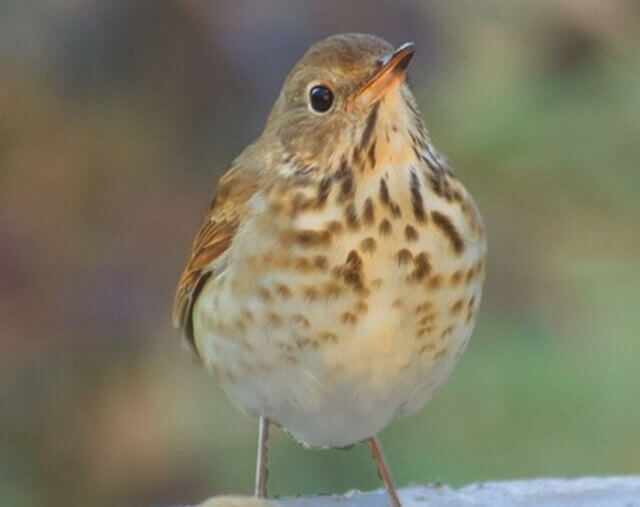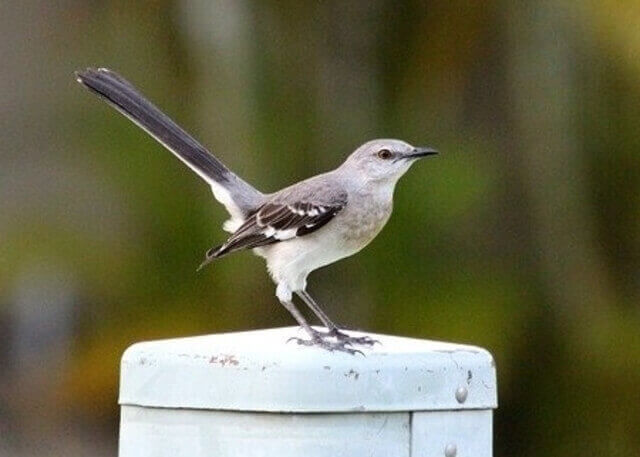Welcome to a fascinating exploration of the avian world’s culinary delights. In this captivating journey, we’ll delve into the intricate relationship between 17 birds that eat serviceberries. Join us as we unravel the secrets of these feathered gourmets and discover the unique stories of each bird’s love affair with serviceberries.
From tree-dwelling songbirds to agile aerial acrobats, get ready to be amazed by the diverse array of avian connoisseurs who feast upon this tiny, sweet treasure of the wild.
Table of Contents
- 1 American Robin
- 2 Baltimore Oriole
- 3 Gray Catbird
- 4 Hairy Woodpecker
- 5 Hermit Thrush
- 6 Mourning Dove
- 7 Cedar Waxwing
- 8 Eastern Bluebird
- 9 Eastern Towhee
- 10 Red-Bellied Woodpecker
- 11 Rose-Breasted Grosbeak
- 12 Northern Cardinal
- 13 Northern Flicker
- 14 Northern Mockingbird
- 15 Yellow Warbler
- 16 Wood Thrush
- 17 Brown Thrasher
- 18 Frequently Asked Questions
- 19 Author
American Robin
- Length: 6.7-7.5 in (17-19 cm)
- Weight: 1.1-1.4 oz (30-40 g)
- Wingspan: 9.1-11.8 in (23-30 cm)
- Range: Northeast United States, southeast Canada, parts of Central America
- Habitat: Wetlands, marshes, meadows, forest edges, suburban yards
The American Robin, a petite migratory songbird indigenous to North America, maintains a varied diet comprising small insects, earthworms, spiders, and an assortment of berries. Particularly notable is their early consumption of serviceberries, even before their ripening, as they eagerly await the availability of alternative food sources. Serviceberries constitute a significant portion of their diet, contributing up to 40% of their overall food intake.
Baltimore Oriole
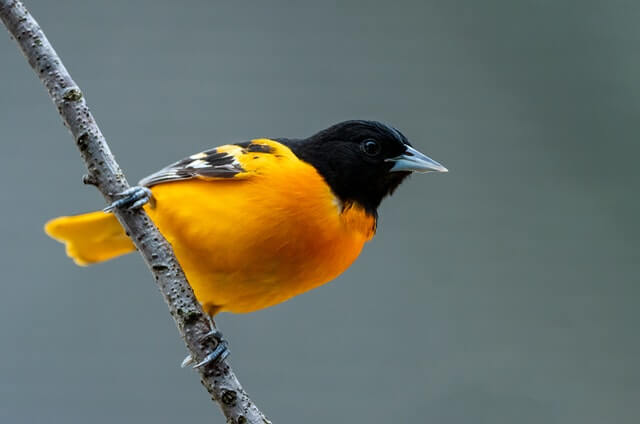
- Length: 6.7-7.5 in (17-19 cm)
- Weight: 1.1-1.4 oz (30-40 g)
- Wingspan: 9.1-11.8 in (23-30 cm)
- Range: Northeast US, southeast Canada, parts of Central America
- Habitat: Wetlands, marshes, meadows, forest edges, suburban yards
The Baltimore Orioles are a migratory bird that can be found in the United States, Canada, and Mexico. Serviceberries are a critical food source for the Baltimore Orioles during their breeding season. These berries can make up to 25% of their diet, and it is important that they have access to them, as they provide much-needed nutrients. The berry season is typically from June through September, so there should be plenty of opportunities to observe the birds’ behavior around these tasty treats.
Gray Catbird
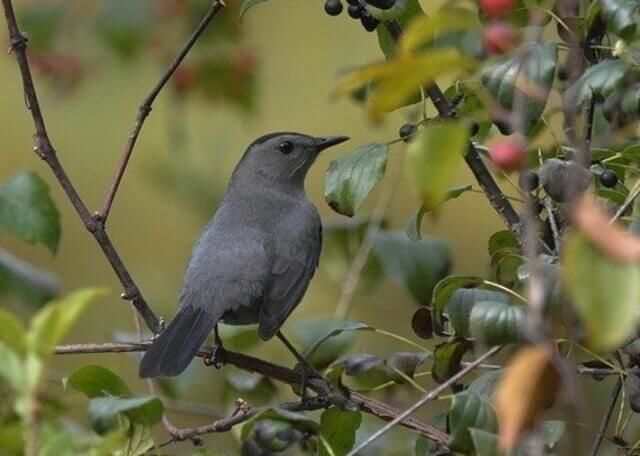
- Length: 8.3-9.4 in (21-24 cm)
- Weight: 0.8-2.0 oz (23.2-56.5 g)
- Wingspan: 8.7-11.8 in (22-30 cm)
- Range: Eastern United States and Canada, and the Great Lakes region
- Habitat: Deciduous forests, swamps, shrub or tree thickets, hedges along roadsides and farms, and backyards with tall bushes near homesites
The Gray Catbird, a medium-sized songbird belonging to the mimid family, can be spotted across a vast range encompassing North America, Central America, and South America. These versatile birds exhibit a varied diet, primarily consisting of insects but also include berries, fruits, seeds, and nuts in their culinary preferences. Of particular interest to Gray Catbirds are serviceberries, also known as Juneberries, for their sweet, nutrient-rich juice.
Hairy Woodpecker

- Length: 7.1-10.2 in (18-26 cm)
- Weight: 1.4-3.4 oz (40-95 g)
- Wingspan: 13.0-16.1 in (33-41 cm)
- Range: Eastern region of Canada and southward into Texas, Oklahoma, Arkansas, Missouri, Kansas, Iowa, and further westward into New Mexico and Arizona.
- Habitat: Lives mainly in forests and woodlands, parks or other types of residential areas.
Hairy Woodpeckers are found in North America, Europe, and Asia, though they have been spotted as far south as Mexico. They can be seen perching high up in trees where they look for prey such as ants or other insects. Hairy Woodpeckers can also be seen eating serviceberries which they find from the ground or from trees when they’re climbing around them looking for insects to eat.
Hermit Thrush
- Length: 5.5-7.1 in (14-18 cm)
- Weight: 0.8-1.3 oz (23-37 g)
- Wingspan: 9.8-11.4 in (25-29 cm)
- Range: Southern Canada to Northern Florida in the US.
- Habitat: Mature tree-covered forests or woodlands ideal for nesting sites.
The Hermit Thrush is a medium-sized brownish bird that can be found in eastern North America and northern Mexico, but they are also occasionally seen as far south as Guatemala. The Hermit Thrush will feed on serviceberry fruit during the summer, and also during the fall migration season when they are passing through Canada to their wintering grounds in Central America or Mexico.
Mourning Dove
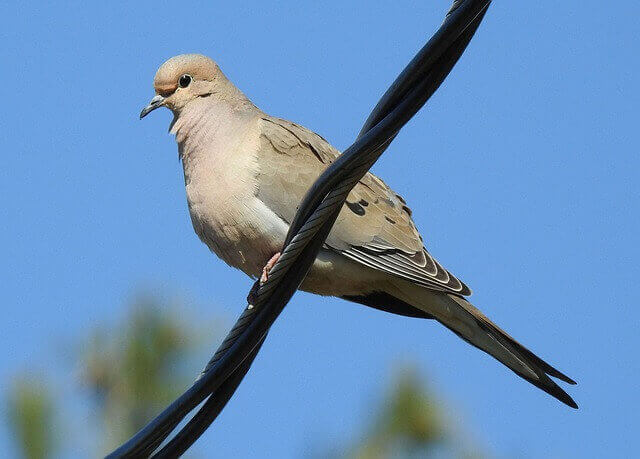
- Length: 9.1-13.4 in (23-34 cm)
- Weight: 3.4-6.0 oz (96-170 g)
- Wingspan: 17.7 in (45 cm)
- Range: Includes all but the southernmost regions of the United States, Canada, and Mexico.
- Habitat: Agricultural fields, grasslands, and shrubbery with trees.
Mourning doves are drawn to the tempting sweetness of serviceberry, often referred to as shadbush. These berries start out tart when unripe but become delectably flavorful once fully ripened. These birds can often be seen diligently feasting on these berries for extended periods, ensuring they satisfy their hunger before seeking out additional food sources elsewhere.
Cedar Waxwing
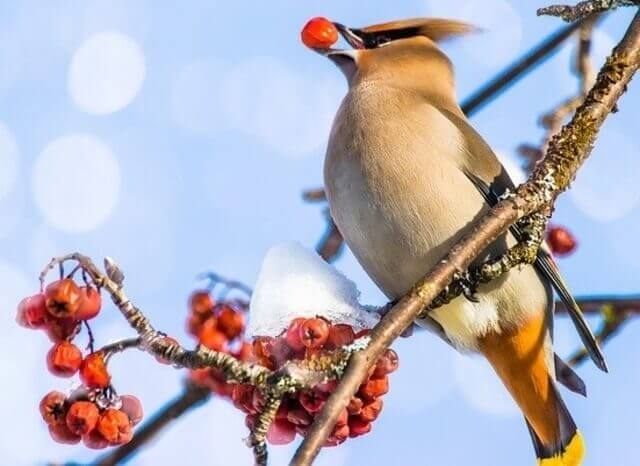
- Length: 5.5-6.7 in (14-17 cm)
- Weight: 1.1 oz (32 g)
- Wingspan: 8.7-11.8 in (22-30 cm)
- Range: Southwestern United States to Canada and south through Mexico.
- Habitat: Woodlands, thickets, and gardens that provide shelter and food sources.
Cedar Waxwings are the quintessential North American bird. They reside year-round in the Eastern United States and Canada but migrate south to escape harsh winters. It is not uncommon for Cedar Waxwings to be seen with their long tongues extended into ripe serviceberries on a warm summer day. This fruit is full of sugar, making it an ideal snack for these beautiful birds that flock together to eat at once!
Eastern Bluebird
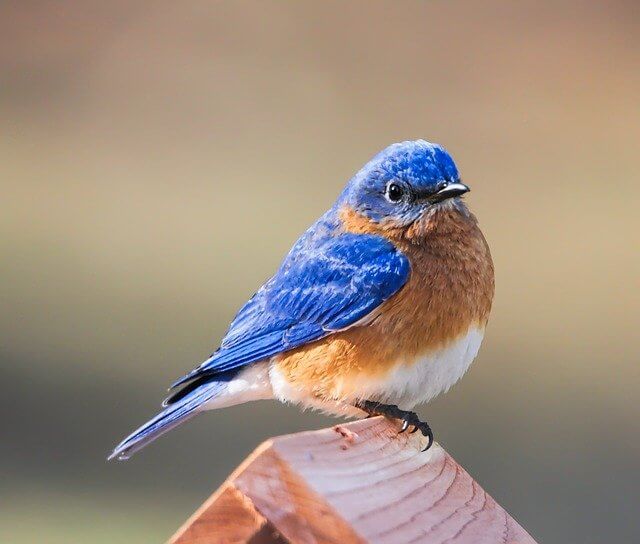
- Length: 6.3-8.3 in (16-21 cm)
- Weight: 1.0-1.1 oz (28-32 g)
- Wingspan: 9.8-12.6 in (25-32 cm)
- Range: Eastern United States and Canada.
- Habitat: Open areas with trees or bushes, such as pastures, parks, or farmlands.
The Eastern Bluebird is a small songbird native to North America. They are found in many parts of the United States and Canada. These birds typically inhabit woodlands, brushy areas, and other natural habitats with trees. The bluebirds feed on insects, fruit, and seeds. Serviceberries are one of their favorite food because they contain nutrients which the bird needs for its feathers and egg production.
Eastern Towhee
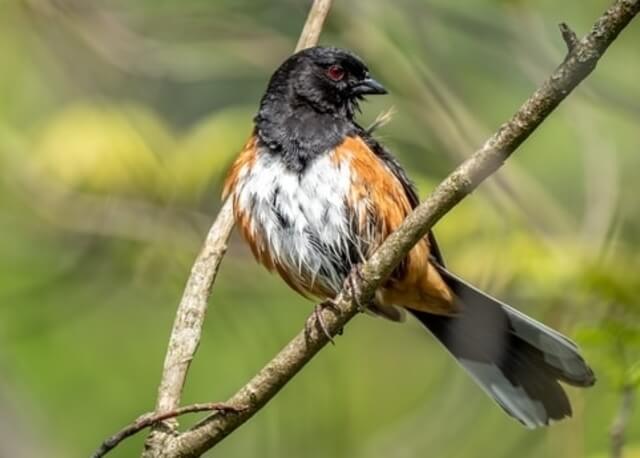
- Length: 6.8-8.2 in (17.3-20.8 cm)
- Weight: 1.1-1.8 oz (32-52 g)
- Wingspan: 7.9-11.0 in (20-28 cm)
- Range: Most of Canada east of the Rocky Mountains, all the United States east of the Rockies except for Florida.
- Habitat: Deciduous forests, old fields, parks, gardens and other green spaces.
The Eastern Towhee is an oversized sparrow that lives in the eastern part of North America. The Eastern Towhee’s diet mainly consists of seeds, berries like cherries, mulberries, black raspberries, chokecherries and serviceberries (sometimes called “Juneberry”), and insects such as beetles or grasshoppers which it gleans from leaves or bark on trees while perched on branches or hopping along.
Red-Bellied Woodpecker
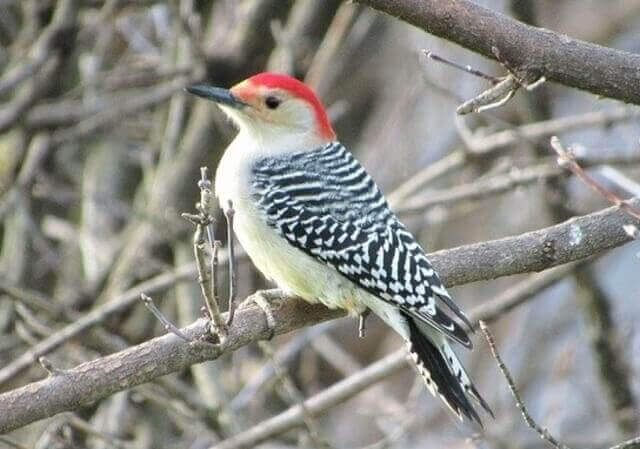
- Length: 9.4 in (24 cm)
- Weight: 2.0-3.2 oz (56-91 g)
- Wingspan: 13.0-16.5 in (33-42 cm)
- Range: It lives throughout the eastern United States, as well as all of Canada.
- Habitat: Deciduous forests or mixed woods, usually near water sources such as streams, lakes, or swamps.
Red-bellied Woodpeckers are one of the most common woodpecker species in North America. The most distinguishing feature of the red-bellied woodpecker is its bright, scarlet underbelly. Red-bellied woodpeckers are also distinguished by their short, stout beaks and powerful claws, which they use to cling to tree bark as they search for insects hiding within crevices in the bark. It has been observed that serviceberries make up about 20% of this bird’s diet during the summer.
Rose-Breasted Grosbeak

- Length: 7.1-8.3 in (18-21 cm)
- Weight: 1.4-1.7 oz (39-49 g)
- Wingspan: 11.4-13.0 in (29-33 cm)
- Range: Eastern United States and Canada, and winters in Central America, South America, Mexico, and Cuba.
- Habitat: Deciduous forests to swamps to agricultural fields.
The Rose-breasted Grosbeak is a beautiful bird, found in the Eastern United States. The Rose-breasted Grosbeak is a popular bird with people. They have been called the “Cadillac of Birds” and they are very charismatic. They are most often seen in suburban areas, where they will eat insects and berries from ornamental trees planted by homeowners. One of their favorite foods is serviceberries which are high in sugar and make for an excellent food source when other food sources are still scarce.
Northern Cardinal
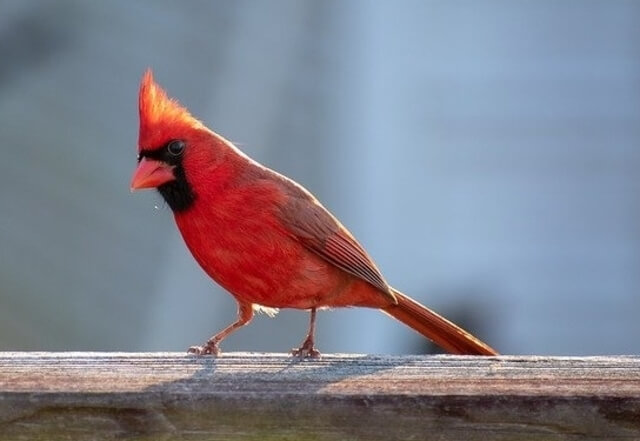
- Length: 8.3-9.1 in (21-23 cm)
- Weight: 1.5-1.7 oz (42-48 g)
- Wingspan: 9.8-12.2 in (25-31 cm)
- Range: All over the United States, and in southern Canada.
- Habitat: Meadows, forest edges, farmlands, and suburbs.
The Northern Cardinal, a striking red bird native to the Eastern and Central United States, is often associated with a diet primarily consisting of seeds and insects. However, their culinary preferences extend beyond these staples, as evidenced by their winter feasts on serviceberries. During the colder months, when food sources become scarce, Northern Cardinals are known to readily consume these berries. In order to maintain their health, adult cardinals typically ingest about 8-10% of their body weight each day, a remarkable adaptation to the challenges of winter survival.
Northern Flicker
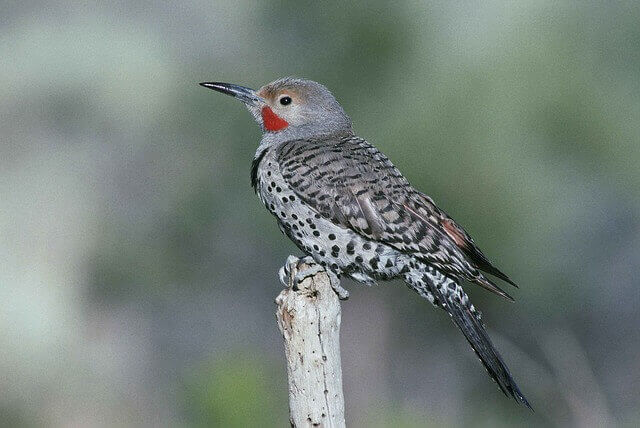
- Length: 11.0-12.2 in (28-31 cm)
- Weight: 3.9-5.6 oz (110-160 g)
- Wingspan: 16.5-20.1 in (42-51 cm)
- Range: Northern Canada to the southern United States.
- Habitat: Forests, woodlands, mountain areas and even urban landscapes such as the suburbs or parks.
Northern Flickers are in the woodpecker family, and are found in most parts of Canada and all throughout the United States, but they only live in areas where there is a large number of deciduous trees. Most of the time, they feed on insects and spiders found in trees, but during fall months when other food sources are scarce, they will eat serviceberries. They have a long tongue that can reach out far enough to get fruit or bugs from branches or leaves.
Northern Mockingbird
- Length: 8.3-10.2 in (21-26 cm)
- Weight: 1.6-2.0 oz (45-58 g)
- Wingspan: 12.2-13.8 in (31-35 cm)
- Range: United States, Canada, and Mexico.
- Habitat: Temperate deciduous forest, scrubby woodlands, thickets and edges of marshes or other wet areas.
The Northern Mockingbird is a songbird that resides in North America. They are most commonly found in areas with trees and bushes, which makes them very territorial. Their territory can range from one acre to up to 5 acres. They usually eat insects, berries, seeds, fruits, and other invertebrates in the summer months. One berry they like to eat is serviceberries which usually ripen during late summer (July-August).
Yellow Warbler

- Length: 4.7-5.1 in (12-13 cm)
- Weight: 0.3-0.4 oz (9-11 g)
- Wingspan: 6.3-7.9 in (16-20 cm)
- Range: Southern United States to Canada. Spends the winter in the Central and South America.
- Habitat: Brushy areas, marshes and thickets near streams and rivers.
Yellow Warblers are one of the most common types of birds in North America, and they love to feast on serviceberries. Warblers are typically insectivores, but they will eat Serviceberries when insects are scarce. They will eat serviceberries while they are migrating. These birds gorge themselves on berries and build up fat reserves in order to survive their long journey south for the winter.
Wood Thrush
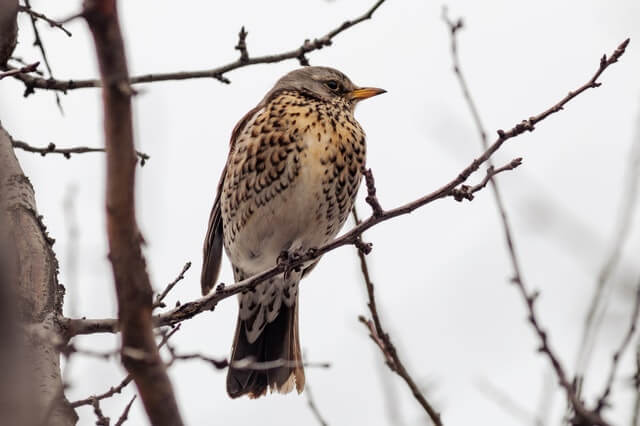
- Length: 7.5-8.3 in (19-21 cm)
- Weight: 1.4-1.8 oz (40-50 g)
- Wingspan: 11.8-13.4 in (30-34 cm)
- Range: Eastern United States and Canada. Winters in Central America, South America, or Cuba.
- Habitat: Deciduous forests, thickets, and swamps.
The Wood Thrush is a medium-sized songbird, closely related to the American Robin, that lives in the Eastern United States. The bird has a varied diet consisting of worms, insects, fruits, and berries. Wood thrushes are often seen eating serviceberries in early spring. They enjoy them a lot and do not mind the tart taste. The birds will come out in droves when these berries are around, eating until they’re satisfied.
Brown Thrasher
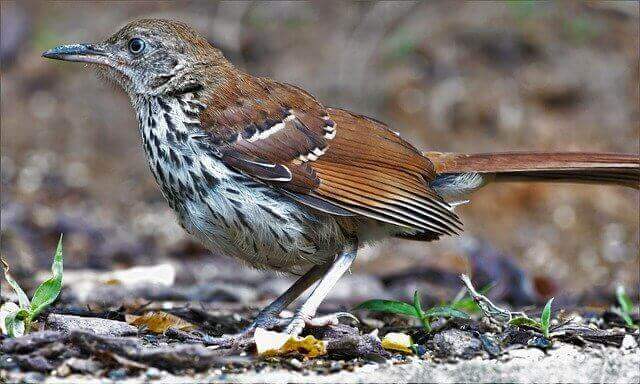
- Length: 9.1-11.8 in (23-30 cm)
- Weight: 2.1-3.1 oz (61-89 g)
- Wingspan: 11.4-12.6 in (29-32 cm)
- Range: Canada, Southeastern US, and Mexico.
- Habitat: Forests, shrublands, grasslands, and wetlands as well as near streams and lakes.
The Brown Thrasher is a large songbird found in North America in the New World thrasher family. It gets its name from the “song” it sings with a loud, rolling trill, and also for its habit of beating on branches to communicate with other birds. The birds love to eat serviceberries that are in season from July to September. The bird will look for ripe berries, or wait until they fall off the branch or on the ground.
Frequently Asked Questions
Do hummingbirds like serviceberry?
The Serviceberry tree blooms small white flowers which attract insects. Hummingbirds enjoy feeding on the insects, as well as the nectar of these blossoms because they are high in sugar, making them a reliable food source for hummingbirds during winter when other sources may be scarce.
Do bluebirds eat Serviceberries?
Bluebirds will enjoy eating serviceberries when they are available, but do not need to rely solely on them for sustenance. They also feed on insect larvae and insects such as ants or caterpillars that the serviceberry tree attracts.
Are serviceberries messy?
Serviceberry trees can be a pain to maintain. Some people may think that Serviceberry trees are messy because of the fallen leaves on the ground during fall time. The dried out leaves will stick to your shoes or track into your house. And when you shake them off outside it will scatter more of those tiny brown pieces everywhere!
How tall does a serviceberry tree get?
Serviceberry trees are deciduous, meaning they lose their leaves in the fall. The size of a serviceberry tree can vary greatly depending on factors such as climate and soil conditions. In the Midwest, where serviceberries grow best, a typical height is 15-25 ft., with a diameter of 3-4 ft.
Which serviceberry is best for birds?
The downy serviceberry is a wonderful option for your backyard, orchard, or home. They are very fast growing and hardy. The fruit of the downy serviceberry is edible by humans as well as birds which means they are great for attracting them to your yard with food!

